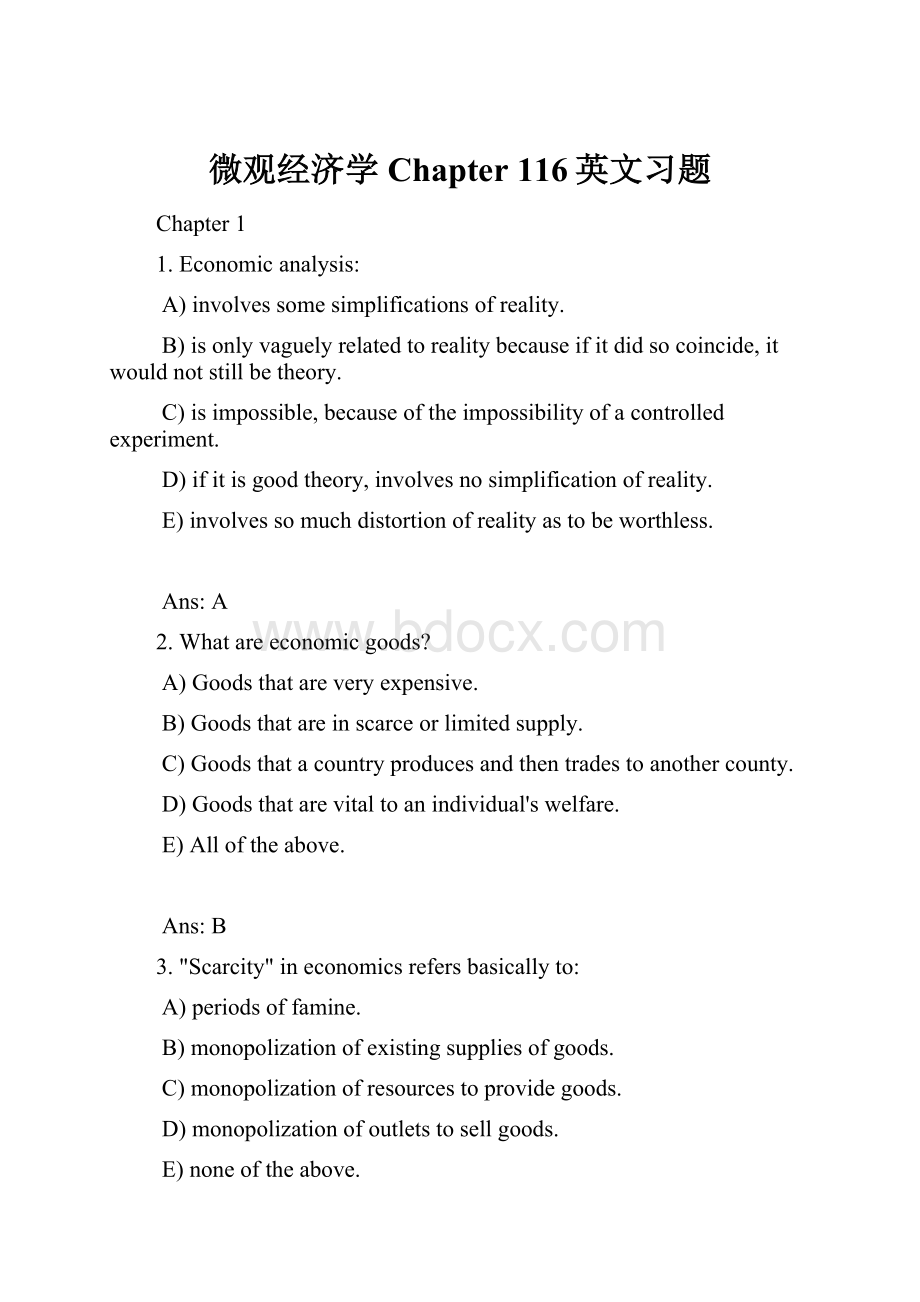微观经济学Chapter 116英文习题.docx
《微观经济学Chapter 116英文习题.docx》由会员分享,可在线阅读,更多相关《微观经济学Chapter 116英文习题.docx(88页珍藏版)》请在冰豆网上搜索。

微观经济学Chapter116英文习题
Chapter1
1.Economicanalysis:
A)involvessomesimplificationsofreality.
B)isonlyvaguelyrelatedtorealitybecauseifitdidsocoincide,itwouldnotstillbetheory.
C)isimpossible,becauseoftheimpossibilityofacontrolledexperiment.
D)ifitisgoodtheory,involvesnosimplificationofreality.
E)involvessomuchdistortionofrealityastobeworthless.
Ans:
A
2.Whatareeconomicgoods?
A)Goodsthatareveryexpensive.
B)Goodsthatareinscarceorlimitedsupply.
C)Goodsthatacountryproducesandthentradestoanothercounty.
D)Goodsthatarevitaltoanindividual'swelfare.
E)Alloftheabove.
Ans:
B
3."Scarcity"ineconomicsrefersbasicallyto:
A)periodsoffamine.
B)monopolizationofexistingsuppliesofgoods.
C)monopolizationofresourcestoprovidegoods.
D)monopolizationofoutletstosellgoods.
E)noneoftheabove.
Ans:
E
4."Distribution"ineconomicsrefersto:
A)retailing,wholesaling,andtransportation.
B)what.
C)how.
D)forwhom.
E)noneoftheabove.
Ans:
D
5.Thethreequestionsofwhat,how,andforwhom:
A)relatetothethreefactorsofproduction.
B)existbecauseofscarcity.
C)aremoreofaprobleminamarketeconomy.
D)aremoreofaprobleminacommandeconomy.
E)arenolongerrelevant.
Ans:
B
6.Thedescriptionofeconomicsas,"coolheadsintheserviceofwarmhearts",meansthat:
A)allocatingscarceresourcesmayrequirepainfuldecisions.
B)costsandbenefitsneedtobeweighedobjectively.
C)theproperbalancemustbestruckbetweenthedisciplineofthemarketandthegenerosityofthewelfarestate.
D)alloftheabove.
E)noneoftheabove.
Ans:
D
7.Whenmovingalongaproductionpossibilitiesfrontier,theopportunitycosttosocietyofobtainingmoreofoneofthetwogoods:
A)ismeasuredindollarterms.
B)usuallydecreasesasmoreofthegoodisproduced.
C)ismeasuredbytheamountoftheothergoodthatmustbegivenup.
D)ismeasuredbytheadditionalresourcesthatmustbeusedtoproducethegood.
E)isusuallyconstant.
Ans:
C
8.Thesedatareflectthreepossiblecombinationsoffoodandnothingthatcanbeproducedfromagivensetofresources.
Food1050
ClothingOX50
Refertotheabovedata.Ifbothclothingandfoodalwaysuseallinputsinthesameproportion,thenXmustbe:
A)25.
B)morethan25.
C)lessthan25.
D)50.
E)cannotnotbedeterminedfromthedata
Ans:
A
9.Beingontheproduction-possibilityfrontierbetweengunsandbuttermeansthat:
A)itisimpossibletoproduceanymoreguns.
B)itisimpossibletoproduceanymorebutter.
C)moregunscanbeproducedonlybydoingwithoutsomebutter.
D)populationisinequilibrium.
E)ifsocietybecomesmoreproductiveinproducingbutter,thenwecanhavemorebutterbutnotmoreguns.
Ans:
C
10.Ashiftinaproduction-possibilityfrontiercanresultfrom:
A)unemployment.
B)inflation.
C)changesinproductiontechniques.
D)changesinthecombinationofgoodsproduced.
E)changesinconsumers'tastes.
Ans:
C
11
Figure1-1
Whichpointontheproduction-possibilityfrontiersdrawninFigure1indicatesnoconsumptiongoodsbeingproduced?
A)A.
B)B.
C)C.
D)D.
E)E.
Ans:
E
12.Ofthefollowingpoints,whichpointreflectsthemostefficientuseofavailableresourcesinrelationtofrontierAEinFigure1-1?
A)F.
B)G.
C)C.
D)H.
E)Cannottellfromtheinformationprovided.
Ans:
C
13.RelativetofrontierA'E'inFigure1-1,whichofthefollowingpointsisleastefficient?
A)B'.
B)C'.
C)B.
D)C.
E)F.
Ans:
E
14.PointAonwhichpanelinFigure1-2representsaninefficientuseofresources?
A)PanelA.
B)PanelB.
C)PanelC.
D)PanelD.
E)PanelE.
Ans:
D
15.Foratheorytobeuseful,itmustbeconfirmedineachtestcase.
Ans:
False
CHAPTER2
1.Inamarketsystem,thewhatdecisionismademostbasicallyby
A)representativegovernment.
B)nationalplanning.
C)bankers.
D)advertisersandtheirabilitytopersuadebuyers.
E)spendingdecisionsofthosewithmoney.
Ans:
E
2.Inamarketeconomy,thepresumedharmonybetweenindividualandpublicinterestdependsupon:
A)thegoodwillofprivatebusinesspeople.
B)carefulplanningandcoordinationofeconomicactivity.
C)altruismonthepartofconsumers.
D)competitivemarketsandthepursuitofself-interestbyindividuals.
E)thewisdomofgovernmentdecisions.
Ans:
D
3.Pollutioncontrolpolicyisdirectedfirstandforemostatimproving:
A)equity.
B)efficiency.
C)stability.
D)alloftheabove.
E)noneoftheabove
Ans:
B
4.Whoisinchargeofamarketeconomy?
Thatis,whatagentsandfactorsarethemostimportantindeterminingmarketoutcomes?
A)Largecompanies.
B)Congressandthepresident.
C)Consumersalone.
D)Allproducers.
E)Consumersandtechnology.
Ans:
E
5.Theprincipleofthe"invisiblehand"claimsthat:
A)theselfishpursuitsofeveryone'sowninterestwillleadtothebestgoodforallundermarketcompetition.
B)governmentmustgentlyguideeconomicactivitysothatthebestforallwillbeattained.
C)governmentpoliciesworklikeaninvisiblehand,steeringresourcestotheirbestuse.
D)producersmustquietlycooperatesothatpricesarenotsolowastocauselosses.
E)noneoftheabove.
Ans:
A
6.Consumersvotetheirdollarsprimarilyin:
A)labormarkets.
B)landmarkets.
C)capitalmarkets.
D)goodsmarkets.
E)noneoftheabove.
Ans:
D
7.Whichofthefollowingstatementsistrueofspecialization?
A)Specializationisinconsistentwiththeideaofindividualfreedom.
B)Economiesthatpracticeadivisionoflaboraremorallysuperiortothosethatdonot.
C)Inacceptingspecialization,apersonsacrificeshisorherowninterestsforthesakeofsociety'sinterest.
D)Whilespecializationhasenormousadvantages,thecostsoutweighthem.
E)Increasedproductivityismorelikelytobeachievedthroughspecialization.
Ans:
E
8.Whichofthefollowingisnotanexampleofgovernmentregulationdesignedtocurbanegativeexternality?
A)Anti-childlaborlaws.
B)Anti-pollutionlaws.
C)Anationalsalestax.
D)Legislationagainststripmining.
E)TheCleanAirAct.
Ans:
C
9.Pricesinfactormarketsareprimarilydeterminedby
A)governmentregulation.
B)bigbusinesscollusion.
C)theinteractionofbusinesssupplywithouthouseholddemand.
D)theinteractionofhouseholdsupplywithbusinessdemand.
E)noneoftheabove.
Ans:
D
10.Aneconomydominatedbyimperfectcompetitionischaracterizedby
A)toomuchoutput,andlowpricescomparedtoperfectcompetition.
B)sameamountofoutput,andlowpricescomparedtoperfectcompetition.
C)toolittleoutput,andlowpricescomparedtoperfectcompetition.
D)toolittleoutput,andhighpricescomparedtoperfectcompetition.
E)toomuchoutput,andhighpricescomparedtoperfectcompetition.
Ans:
D
11.Whichofthefollowingisthekeyrequirementforimperfectcompetition?
A)Advertising.
B)Manybuyers.
C)Manysellers.
D)Abilityofabuyerorsellertoaffectagood'sprice.
E)Governmentpolicies.
Ans:
D
12.Ofthethreebasicproblemsinourmoderneconomy,pricesinamarketsystemsolve:
A)whatandforwhom,butphysicalscientistssolvehow.
B)whatandhow,butforwhomisdeterminedbysocialscientists.
C)howandforwhom,butCongresssolvesthewhat.
D)eachoftheabove,andnotwoarecontradictory.
E)noneoftheaboveisaccurate.
Ans:
E
13.Whichofthefollowingwouldbestdetermine,inamarketeconomy,theanswertotheforwhomquestion?
A)Fairness.
B)Internationaltradepatterns.
C)Pricingoffactorsofproductionthatpeopleown.
D)Costminimization.
E)Consumers'tastesandneeds.
Ans:
C
14.Howgoodsareproducedisdeterminedby:
A)consumerdemand.
B)governmentinterventiontoforcebusinessestoproducegoodscheaply.
C)bigbusinessactivity.
D)businesscompetitiontobuyfactorinputsandsellgoodsmostcheaply.
E)noneoftheabove.
Ans:
D
15.A"mixedeconomymayinvolvebothperfectandimperfectcompetition.
Ans:
True
CHAPTER3
1.IfEweretheoldequilibriuminthemarketforwheatinthefigurebelow,andE'thenewone,whichofthefollowingcouldhavecausedthechange?
A)Consumerincomerose,causingasupplyshift.
B)Badweathercausedasupplyshift.
C)Consumerincomerose,causingademandshift.
D)Supplyanddemandbothshifted.
E)Noneoftheaboveareplausibledescriptions.
Ans:
C
2.Thedemandcurveforanormalgoodwillshifttotheleftif:
A)incomeincreases.
B)populationincreases
C)thepriceofasubstitutegooddecreases.
D)alltheabove.
E)noneoftheabove.
Ans:
C
3.Apriceatwhichtheamountpeoplewishtobuyexceedstheamountthatpeoplewishtoproduce(givenupward-slopingsupplycurves):
A)liesabovetheequilibrium,marketclearingprice.
B)liesbelowthemarketclearingprice.
C)willinduceashiftinthedemandscheduletoachieveequilibrium.
D)isimpossible.
E)isnoneoftheabove.
Ans:
B
4.AnincreaseinthesupplyofcommodityXforanygivenpriceofXcouldbeexpectedtobecausedby
A)anincreaseinthepricesofothercommodities.
B)anincreaseinthepricesoffactorsofproductionimportanttothiscommodity.
C)areductioninthepricesoffactorsofprod